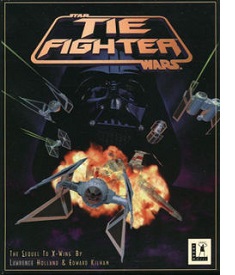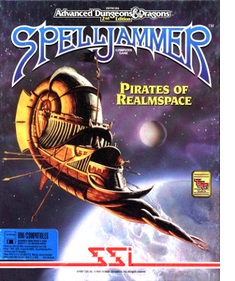![]() It’s flashback time!
It’s flashback time!
Back in November of 2010, there was an Internet meme about video games. It was described as such:
“Don’t take too long to think about it. Fifteen video games you’ve played that will always stick with you. List the first fifteen you can recall in no more than fifteen minutes.”
I don’t do these meme things much; nothing against them, I’m just not interested. But this one caught my attention, so I wrote something. I originally posted this on Facebook on November 12 of 2010. It’s been almost four years since I first wrote the original piece, so I have updated this for 2014.
For a while I used to catalog and describe video games as part of my job, so I’ve played and seen a lot of them. I’m also a fan of computer games, even though I don’t have time to play them very much. All that being said, the fifteen computer games that I will always remember:
- Elder Scrolls III: Morrowind

This is my all-time favorite, and I still play this one when time permits. Heck, I’ve been known to make time for this one. I’ll let the game’s press speak for its merits. If I’m not playing the game, I’m tinkering with the editor to make or change something in the setting. As Computer RPG’s go, this one re-defined the genre. The beautiful and terrifying island of Vvarenfell is teaming with all sorts of creatures and NPCs, each with an agenda of their own, each a potential ally or potential foe. Spelunking though old tombs, caves and ruins is abundant; fans of D&D will feel right at home. But at the same time, Morrowind features epic puzzles and webs of intrigue that culminate into a rather frightening and nerve-wracking resolution. And if that’s not enough, you can design your character any way you want to, and choose from numerous styles of play. The only real restriction is the technology of the setting (vaguely medieval European in flavor). This one has just about everything, and even eight years after its release, it still has a huge online support base. Even its successor, Oblivion, couldn’t quite measure up (though it came darn close). - Sim City

As sandbox games go, this one is a classic. It’s gone through several incarnations, but they all have the same theme: running and managing a sprawling urban metropolis. What to fund, what to cut back, what ordinances to pass and which ones to cancel, where to put train stations, where to locate utilities… all these questions and more add to the fun of Sim City. In some respects this game is less a game and more a jigsaw puzzle where the pieces change shape with every playing. The same scenario can be handled in numerous different ways, and there is no real “right” or “wrong” way to play. The objective is to simply have fun, and Sim City, all incarnations of it, has always delivered. - TIE Fighter

It’s time to root for the bad guy. Lots of people enjoy the Star Wars universe, and there are a lot of fun games based on that setting. But this one has always been one of my favorites. There is something very cathartic about taking the helm of a TIE interceptor and blasting a rebel Y-wing into atoms. There is also something very satisfying about dog-fighting Wedge Antilles to the point where you come to respect the rebel scumbag, or of being personally selected to be Darth Vader’s wing man (within context that’s quite an honor!). TIE fighter is essentially a flight combat sim with a Star Wars twist. It never pretended to be anything else, and in that capacity it delivers. - Legacy of Kain (series)

Good heavens, where can I start. This five-game series is a masterpiece of storytelling, and the story is one of the best fantasy epics ever written (IMO)! What started out as one vampire’s quest for revenge evolved into a battle for the very life force of an entire world. A cast of memorable characters tell the epic tale in small, disjointed pieces that seem to both explain and contradict everything that came before it; nothing totally makes sense until the end of the final title (Defiance). And the characters!!! The elusive Janos Audron, bound to this world by a sense of duty that only he can understand. The mysterious Elder God, who seems to know everything but reveals nothing. There is the she-vampire Umah, simultaneously seductive and frightening. There is Raziel, the enraged, angst-ridden demon who is both friend and foe. And of course, there is Kain, the Scion of Balance: angry, determined, and relentless in his quest to discover both his destiny and that of the world itself. This colorful rogue’s gallery comes to life with the aid of superior voice acting by Simon Templeman, Michael Bell, Tony Jay, Rene Auberjenois, and others. Once you play the original Blood Omen, you won’t want to stop until you finish Defiance, four titles later. And even then, you’ll wish there was more. - Diablo (I and II) and Dungeon Siege


I’ve grouped these two together because they are essentially the same in their theme and game play. Before Morrowind, there was Diablo. This classic title is a perfect rendition of the good old-fashioned “dungeon crawl.” While the puzzles are fairly simple, and the storyline is even simpler, the sheer fun of the is enough to forgive many of the games flaws. The first two Diablo games are still good simple hack-n-slash fun. I haven’t played the third game, so I can’t speak on that one.Dungeon Siege uses the same basic engine as Diablo, and has a very similar storyline. But, it tends to be campier (especially some of the supporting characters), and doesn’t concern itself with mundane things like fatigue or running out of arrows. Siege is also more of a party game, in that you control a group of characters rather than just one. The game play has the same hack-n-slash fun as Diablo, with the added challenge of managing the resources and needs of a large party of characters.
- Skybase and Space Station Manager


This is another case where two titles are essentially the same game. You’ve probably never heard of these, but these programs let you design and build your own space station. You can select what modules to include, assign resources to maintain them, and let the simulation bring life to your structure. These were essentially “sandbox” building games with a space station twist, and for an aspiring sci-fi writer like myself, that’s loads of fun. Skybase looked beautiful and had great sound effects, but it was a memory hog and tended to slow down to a crawl in short order. The company that made it is no longer in business, and there is no help or support available. Space Station Manager is open source and can be found on the web, but you need to work at it. The primary developer abandoned the project a long time ago, so support and development has been sporadic ever since. - Dungeon Keeper (I and II)


Another one for the bad guys. This strategy/simulation involves building an underground labyrinth full of nasty creatures, traps, and the likes. You need to keep your creatures happy by providing them with lodging, food, recreational facilities, and of course, gold. All the while you need to keep an eye out for rampaging adventurers who would love to plunder your domains’ resources. If you’re lucky, you can capture and torture them until they come over to your side. Or, let them perish, and swell your ranks with undead minions. The choice is yours. Most importantly, this game doesn’t take itself very seriously. Even if you can’t win the scenarios, you can still enjoy the campy creatures and the often hilarious narrator. As the box cover says, “It’s good to be bad.”There is a version of Dungeon Keeper for smart phones and tablets, but functionally it is very different from its predecessors. In fact, I would have to say that the mobile version, while fun in its own way, isn’t nearly the game that either of the desktop games were. Your success as a Keeper in the desktop games relied on your ability to organize and plan. A cunning Keeper with minimal resources could do very well if they kept their wits about them. In the mobile version though, success is determined by your willingness to make in-app purchases. In the desktop game, if you have a resource shortfall, you had to figure out ways to recover or substitute them, and sometimes that was half the fun. In the mobile version, every obstacle can ultimately be overcome by doing an in-app purchase. In fact, some times that’s your only viable option, and that’s not much fun at all. Not to mention it can get very expensive. So while the original desktop versions of Dungeon Keeper are among my favorite games of all time, the mobile version most certainly isn’t.
- Sid Meier’s Alpha Centauri

This Sid Meier title is responsible for several hours of lost sleep, at the very least. As a sequel to Civilization, this title has a similar structure and game play. But this time, you’re leading one of seven factions of a shattered human colony in the Alpha Centauri system. You need to research technology, manage resources, and maintain relations with your neighbors, all with the aim of becoming the dominant faction on the planet. As with Civilization, there are different ways to “win” the game; I’ve managed just about all of them. But the real fun is in the playing itself, and of dealing with the small challenges that come up along the way. The graphics and interface are very dated now, and getting it to run on a modern computer takes some tinkering, but it’s worth the trouble. The game play is still as compelling today as when the game was first released (ca. 1998). - Blood

Yet another bad guy, or at least an anti-hero. Blood was a first-person-shooter with a horror theme. You take on the role of Caleb McCain, a wild west gunfighter who made a deal with the devil, almost literally. But things didn’t go as planned, and Caleb found himself traveling the world of the late 1920’s searching for answers. The game is very atmospheric, drawing heavily on the writings of H.P. Lovecraft, and rife with references to movies and books. It’s full of dry-wit humor, puns, and grotesque slapstick. It’s rather gross at times, and it’s not for everyone, but in an industry where most shooters follow the same worn-out formula, Blood was a nice diversion. Also, it’s one of the few shooters I was able to finish without having to use a single cheat code. - Hexen

Hexen was a shooter with a fantasy theme, and all things considered, it had a very interesting story. It had the usual fare of bashing creatures and thwarting various boss monsters, but it also had interesting puzzles that could be approached in a variety of ways. This was due to Hexen’s scripting language, which made it possible to alter the setting based on character actions. This later became a standard in many game titles, particularly Quake, which makes Hexen one of the pioneers in game development. It’s rather dated now, but I do know that after playing Hexen, my expectations of a computer game were much higher. This one re-set the bar. I didn’t need a cheat code for this one either. - Spelljammer: Pirates of Realmspace

If you’ve even heard of this one, then you must be an old time gamer. This one came out around 1990, and was a DOS-based adventure game. You assume control of a magical space ship – a spelljammer – that travels around a fantasy universe where numerous planets are inhabited and magical boats like yours ply the skies. Structurally, Pirates was one of those titles where you buy cargo at one port and try to sell it for profit at another. You would then use the proceeds to buy more lucrative cargo, or upgrade your ship. Lots of games follow this formula. But in Pirates, you could also engage in boarding actions against enemy ships. You would then be given a map with little markers on it representing your character and his crew. It then turned into a small war game, where you moved your pieces around as the situation required, making use of magical spells and special abilities where needed. The technology in this game hasn’t aged well, and the program had some bugs that were never resolved. The graphics look downright hokey by today’s standards, but give it a break. It’s now well over 20 years old! And even so, it’s still fun in it’s own nostalgic way. - Doom (I and II)

What can I say? This was one of the first shooters, and it pretty much defined the genre, for good or ill. Senseless violence, lots of noise, crazy animations, ridiculous cybernetic monsters, enough weapons to power a small army, and practically no plot. This game was the psychological equivalent of a punching bag; a great way to let off some steam. I’ll confess to wasting many an evening on this one. - Trainz

This railroad simulator by the Australian company Auran is like a flight simulator for railroads. The game has two basic modes. One is the simulation itself, where you can run and operate simulated trains on a variety of routes from all over the world. Depending on which add-on supplements you have, you can expand your experience to include historical trains from the earliest days of steam, up through the superdiesel “bullet trains” of today. There are also scenarios that provide timetable and switching puzzles that can bend your mind all over the place. If you enjoy other types of simulators, you’ll probably enjoy this one. But there is another way that Trainz can be fun, and that’s as a virtual model railroad. The “Surveyor” module allows you to change existing routes, create new scenarios, and even create entirely new routes. For a long time I wanted to build a model rail empire, but the space and money required for such a thing proved insurmountable. But with Trainz, I no longer have that problem. My dream layout is taking shape within the simulator, complete with customized livery schemes and a variety of unique geographical features. This layout would have filled an average size room using wood and paper mache. But using this simulator, the entire layout comfortably fits on a portable Passport drive, and those are about the size of a paperback novel. As for cost, the program costs around $40. Most model locomotives go for several times that. So for all of you rail fans and frustrated model railroaders, Trainz may be your answer. - My Singing Monsters

This funny little number by Big Blue Marble has a simple premise: you breed, nurture, and care for a bunch of disturbingly cute little creatures that love to stand around and put on a perpetual concert. It is necessary to manage resources, like money and food, to make sure your critters are happy, and at times this can be difficult. This game is tightly tied to the Internet, and so it often relies on in-app purchases. But unlike many other games for the mobile platforms, the in-app purchases can be avoided if you’re patient. I use them very sparingly. The version I use is for the Android operating system, but there is a version for the iPhone as well. If you want a fun and largely harmless world building game, then My Singing Monsters is worth looking into. Assuming you like, or can tolerate, dew-wop music. - Outpost

This, my last entry, is a special case. The concept of Outpost was great. You were the leader of a human colony on a distant planet, and it was your responsibility to lead that colony to some level of prosperity. The graphics were awesome, the sound effects compelling, and the story used enough real-world science to be uniquely engaging. But there was a problem: the game play sucked like a vacuum cleaner. The program was buggy, the interface was difficult to use, and it took so long to make any real progress that you were more inclined to give up than keep going. Outpost was an example of something that happens all too often in the gaming industry: style over substance, and of good ideas being handled very badly. Which was a darn shame, but there it stands.
And there are my 15 games.
I’ve made some changes to my original take on this, but on the whole I stand with my original list. I’m an “old school” gamer, and don’t have much interest in the online games that have become so popular. There are some recent titles that I would like to look into, but real world responsibilities and other hobbies have prevented me from exploring these. I have no idea when I’ll get around to them, if ever.
Citations:
TARDiS image: Imgkid.com.
The My Singing Monsters logo was borrowed from that games wiki site.
All other images were found through wikipedia.org.
